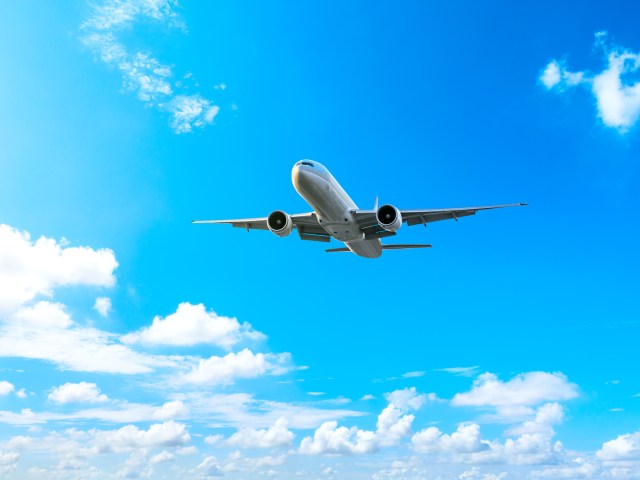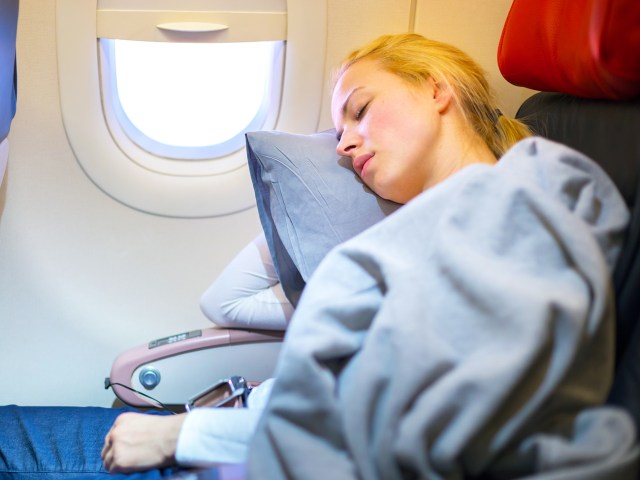Flying from Point A to Point B should take the same amount of time in each direction, right? Well, not exactly. Take, for example, a flight from Los Angeles to New York — the eastbound flight might be scheduled for 5 hours and 15 minutes, but on the return leg, you’ll find the time to be nearly an hour longer. This isn’t because the return flight takes a different route or the skies are busier at certain times of day. Find out why flying in an airplane takes longer if you’re flying westbound versus eastbound.
What Is the Jet Stream?

The simple answer that explains why flights take longer when traveling westbound is wind. More specifically, it’s because of the jet stream, a rapidly moving air current found high in the atmosphere that circulates from west to east. Japanese meteorologist Wasaburo Oishi first wrote about the phenomenon in the 1920s, finding in his experiments with weather balloons that the jet stream is strongest approximately 6 to 8 miles above Earth’s surface — about the altitude that most commercial jets fly today.
Jet streams form because of both the planet’s rotation and the uneven distribution of surface temperatures (colder at the poles, warmer in the tropics). As the warmer and cooler air masses meet, they form a fast-moving current of air high in the atmosphere. By planetary standards, jet streams are pretty narrow — typically reaching about 100 miles across. And there isn’t just one jet stream, but several, including the most prominent polar and subtropical streams.
How Jet Streams Affect Flight Planning

Flight dispatchers and route planners make careful note of the jet streams when determining flight paths. Not only do they shift locations from north to south, but jet streams also vary in strength depending on season. They tend to be strongest in winter, reaching maximum speeds of up to 275 mph and becoming less intense during the summer months.
These changes also affect flight schedules, as Cathay Pacific Airways’ head of line operations explains. In 2023, the airline’s shortest flight time on its regular route from Hong Kong to Los Angeles was 12 hours and 12 minutes in December, while the longest flight during that same year was 13 hours and 38 minutes in July.
Because the jet stream is stronger in winter and the plane is flying westbound, in the direction of the prevailing winds, the December flight time was shortened by the jet essentially being able to “ride” the jet stream and being propelled by tailwinds. On the way back, flying the same route would mean going up against headwinds that add considerably to the flight time. By carefully planning flights around these jet streams, airlines can cut down on fuel costs and save time spent in the air.
If jet streams are particularly strong, you might also find some surprising flight plans. According to Cathay Pacific, in 2022 the airline operated some flights from New York to Hong Kong across the Atlantic, instead of the usual route over the Pacific. Though flying across the Atlantic was longer in distance, according to the airline, the “strong winds made it quicker to hitch a lift with the Atlantic jet stream. We saved 45 minutes.”
The Impact on Long-Haul Flights

While jet streams can account for a difference of about an hour on a transcontinental flight in the U.S., the effect is more noticeable on transcontinental flights such as the aforementioned example. But flying from Los Angeles to Hong Kong is far from the longest flight you can take these days — thanks to advancements in aircraft technology, it’s now possible to fly nonstop between such far-flung places as Singapore and New York, which is currently the world’s longest flight.
However, as route planners push the range of an aircraft up to its limits, any variations in the jet stream can cause headaches. Take, for instance, Air New Zealand’s longest route, from Auckland to New York. The journey typically takes 17.5 hours, but if there’s a particularly strong jet stream, the aircraft will be forced to take on more weight in fuel, which means the airline has sometimes been forced to bump passengers or fly without their bags, according to aviation website Simple Flying.
Scientists also believe that the jet stream is responsible for a phenomenon known as clear air turbulence, which has been impacting more flights as of late. Aircraft flying near the edge of the jet stream can encounter this type of turbulence due to differences in wind speed, but the turbulence can be tricky to predict, as it often happens in cloudless skies and doesn’t show up on radar. That’s why it’s always important to pay attention to flight attendants’ instructions and keep your seat belt fastened while seated.
More from our network
Daily Passport is part of Optimism, which publishes content that uplifts, informs, and inspires.























